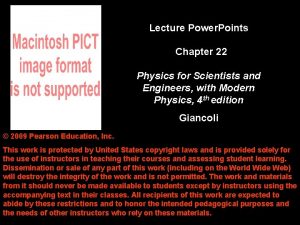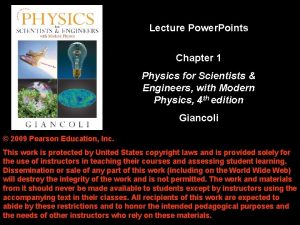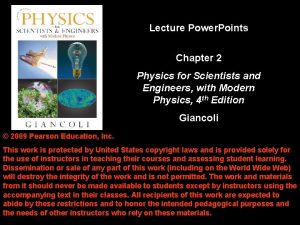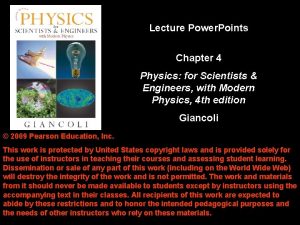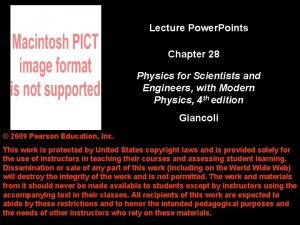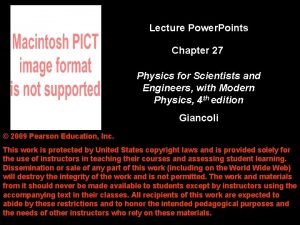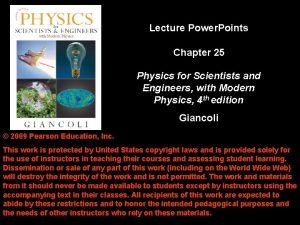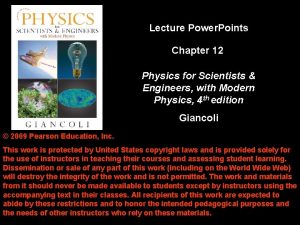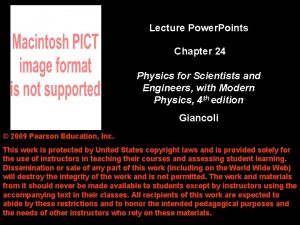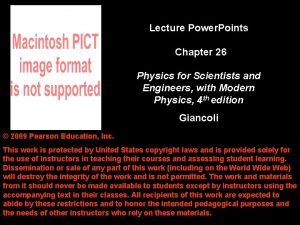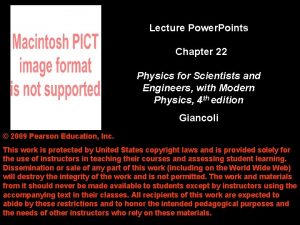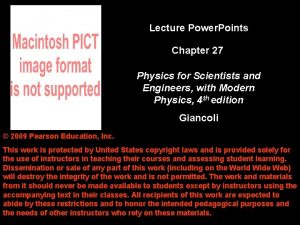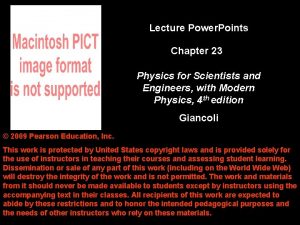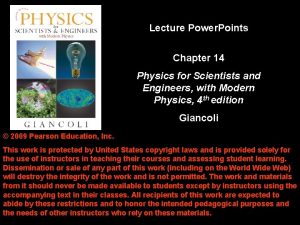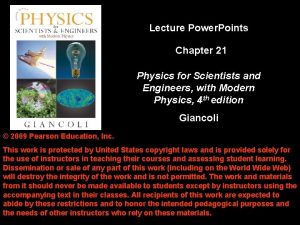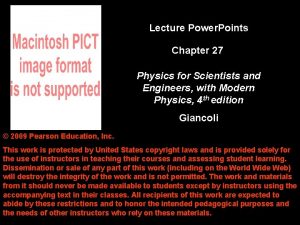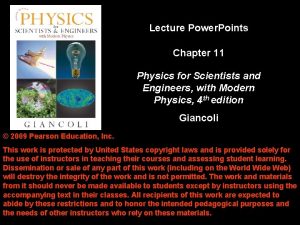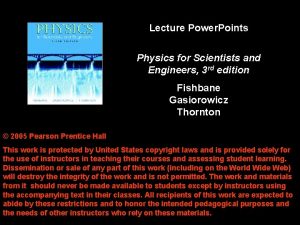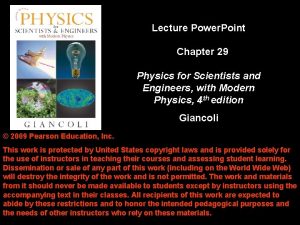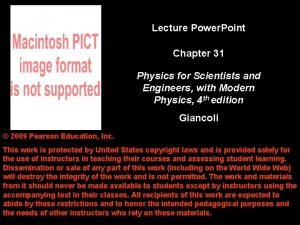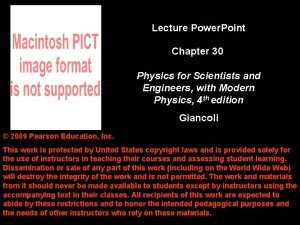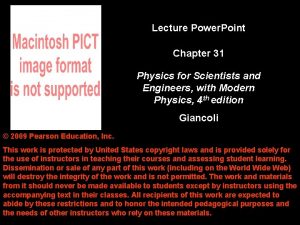Lecture Power Points Chapter 26 Physics for Scientists





















































- Slides: 53

Lecture Power. Points Chapter 26 Physics for Scientists and Engineers, with Modern Physics, 4 th edition Giancoli © 2009 Pearson Education, Inc. This work is protected by United States copyright laws and is provided solely for the use of instructors in teaching their courses and assessing student learning. Dissemination or sale of any part of this work (including on the World Wide Web) will destroy the integrity of the work and is not permitted. The work and materials from it should never be made available to students except by instructors using the accompanying text in their classes. All recipients of this work are expected to abide by these restrictions and to honor the intended pedagogical purposes and the needs of other instructors who rely on these materials. Copyright © 2009 Pearson Education, Inc.

Chapter 26 DC Circuits Copyright © 2009 Pearson Education, Inc.

Units of Chapter 26 • EMF and Terminal Voltage • Resistors in Series and in Parallel • Kirchhoff’s Rules • Series and Parallel EMFs; Battery Charging • Circuits Containing Resistor and Capacitor (RC Circuits) • Electric Hazards • Ammeters and Voltmeters Copyright © 2009 Pearson Education, Inc.

26 -1 EMF and Terminal Voltage Electric circuit needs battery or generator to produce current – these are called sources of emf. Battery is a nearly constant voltage source, but does have a small internal resistance, which reduces the actual voltage from the ideal emf: Copyright © 2009 Pearson Education, Inc.

26 -1 EMF and Terminal Voltage This resistance behaves as though it were in series with the emf. Copyright © 2009 Pearson Education, Inc.

26 -1 EMF and Terminal Voltage Example 26 -1: Battery with internal resistance. A 65. 0 -Ω resistor is connected to the terminals of a battery whose emf is 12. 0 V and whose internal resistance is 0. 5 Ω. Calculate (a) the current in the circuit, (b) the terminal voltage of the battery, Vab, and (c) the power dissipated in the resistor R and in the battery’s internal resistance r. Copyright © 2009 Pearson Education, Inc.

26 -2 Resistors in Series and in Parallel A series connection has a single path from the battery, through each circuit element in turn, then back to the battery. Copyright © 2009 Pearson Education, Inc.

26 -2 Resistors in Series and in Parallel The current through each resistor is the same; the voltage depends on the resistance. The sum of the voltage drops across the resistors equals the battery voltage: Copyright © 2009 Pearson Education, Inc.

26 -2 Resistors in Series and in Parallel From this we get the equivalent resistance (that single resistance that gives the same current in the circuit): Copyright © 2009 Pearson Education, Inc.

26 -2 Resistors in Series and in Parallel A parallel connection splits the current; the voltage across each resistor is the same: Copyright © 2009 Pearson Education, Inc.

26 -2 Resistors in Series and in Parallel The total current is the sum of the currents across each resistor: , Copyright © 2009 Pearson Education, Inc.

26 -2 Resistors in Series and in Parallel This gives the reciprocal of the equivalent resistance: Copyright © 2009 Pearson Education, Inc.

26 -2 Resistors in Series and in Parallel An analogy using water may be helpful in visualizing parallel circuits. The water (current) splits into two streams; each falls the same height, and the total current is the sum of the two currents. With two pipes open, the resistance to water flow is half what it is with one pipe open. Copyright © 2009 Pearson Education, Inc.

26 -2 Resistors in Series and in Parallel Conceptual Example 26 -2: Series or parallel? (a) The lightbulbs in the figure are identical. Which configuration produces more light? (b) Which way do you think the headlights of a car are wired? Ignore change of filament resistance R with current. Copyright © 2009 Pearson Education, Inc.

26 -2 Resistors in Series and in Parallel Conceptual Example 26 -3: An illuminating surprise. A 100 -W, 120 -V lightbulb and a 60 -W, 120 -V lightbulb are connected in two different ways as shown. In each case, which bulb glows more brightly? Ignore change of filament resistance with current (and temperature). Copyright © 2009 Pearson Education, Inc.

26 -2 Resistors in Series and in Parallel Example 26 -4: Circuit with series and parallel resistors. How much current is drawn from the battery shown? Copyright © 2009 Pearson Education, Inc.

26 -2 Resistors in Series and in Parallel Example 26 -5: Current in one branch. What is the current through the 500 -Ω resistor shown? (Note: This is the same circuit as in the previous problem. ) The total current in the circuit was found to be 17 m. A. Copyright © 2009 Pearson Education, Inc.

26 -2 Resistors in Series and in Parallel Conceptual Example 26 -6: Bulb brightness in a circuit. The circuit shown has three identical lightbulbs, each of resistance R. (a) When switch S is closed, how will the brightness of bulbs A and B compare with that of bulb C? (b) What happens when switch S is opened? Use a minimum of mathematics in your answers. Copyright © 2009 Pearson Education, Inc.

26 -2 Resistors in Series and in Parallel Example 26 -7: A two-speed fan. One way a multiple-speed ventilation fan for a car can be designed is to put resistors in series with the fan motor. The resistors reduce the current through the motor and make it run more slowly. Suppose the current in the motor is 5. 0 A when it is connected directly across a 12 -V battery. (a) What series resistor should be used to reduce the current to 2. 0 A for low-speed operation? (b) What power rating should the resistor have? Copyright © 2009 Pearson Education, Inc.

26 -2 Resistors in Series and in Parallel Example 26 -8: Analyzing a circuit. A 9. 0 -V battery whose internal resistance r is 0. 50 Ω is connected in the circuit shown. (a) How much current is drawn from the battery? (b) What is the terminal voltage of the battery? (c) What is the current in the 6. 0 -Ω resistor? Copyright © 2009 Pearson Education, Inc.

26 -3 Kirchhoff’s Rules Some circuits cannot be broken down into series and parallel connections. For these circuits we use Kirchhoff’s rules. Copyright © 2009 Pearson Education, Inc.

26 -3 Kirchhoff’s Rules Junction rule: The sum of currents entering a junction equals the sum of the currents leaving it. Copyright © 2009 Pearson Education, Inc.

26 -3 Kirchhoff’s Rules Loop rule: The sum of the changes in potential around a closed loop is zero. Copyright © 2009 Pearson Education, Inc.

26 -3 Kirchhoff’s Rules Problem Solving: Kirchhoff’s Rules 1. Label each current, including its direction. 2. Identify unknowns. 3. Apply junction and loop rules; you will need as many independent equations as there are unknowns. 4. Solve the equations, being careful with signs. If the solution for a current is negative, that current is in the opposite direction from the one you have chosen. Copyright © 2009 Pearson Education, Inc.

26 -3 Kirchhoff’s Rules Example 26 -9: Using Kirchhoff’s rules. Calculate the currents I 1, I 2, and I 3 in the three branches of the circuit in the figure. Copyright © 2009 Pearson Education, Inc.

26 -4 Series and Parallel EMFs; Battery Charging EMFs in series in the same direction: total voltage is the sum of the separate voltages. Copyright © 2009 Pearson Education, Inc.

26 -4 Series and Parallel EMFs; Battery Charging EMFs in series, opposite direction: total voltage is the difference, but the lowervoltage battery is charged. Copyright © 2009 Pearson Education, Inc.

26 -4 Series and Parallel EMFs; Battery Charging EMFs in parallel only make sense if the voltages are the same; this arrangement can produce more current than a single emf. Copyright © 2009 Pearson Education, Inc.

26 -4 Series and Parallel EMFs; Battery Charging Example 26 -10: Jump starting a car. A good car battery is being used to jump start a car with a weak battery. The good battery has an emf of 12. 5 V and internal resistance 0. 020 Ω. Suppose the weak battery has an emf of 10. 1 V and internal resistance 0. 10 Ω. Each copper jumper cable is 3. 0 m long and 0. 50 cm in diameter, and can be attached as shown. Assume the starter motor can be represented as a resistor Rs = 0. 15 Ω. Determine the current through the starter motor (a) if only the weak battery is connected to it, and (b) if the good battery is also connected. Copyright © 2009 Pearson Education, Inc.

26 -5 Circuits Containing Resistor and Capacitor (RC Circuits) When the switch is closed, the capacitor will begin to charge. As it does, the voltage across it increases, and the current through the resistor decreases. Copyright © 2009 Pearson Education, Inc.

26 -5 Circuits Containing Resistor and Capacitor (RC Circuits) To find the voltage as a function of time, we write the equation for the voltage changes around the loop: Since Q = d. I/dt, we can integrate to find the charge as a function of time: Copyright © 2009 Pearson Education, Inc.

26 -5 Circuits Containing Resistor and Capacitor (RC Circuits) The voltage across the capacitor is VC = Q/C: The quantity RC that appears in the exponent is called the time constant of the circuit: Copyright © 2009 Pearson Education, Inc.

26 -5 Circuits Containing Resistor and Capacitor (RC Circuits) The current at any time t can be found by differentiating the charge: Copyright © 2009 Pearson Education, Inc.

26 -5 Circuits Containing Resistor and Capacitor (RC Circuits) Example 26 -11: RC circuit, with emf. The capacitance in the circuit shown is C = 0. 30 μF, the total resistance is 20 kΩ, and the battery emf is 12 V. Determine (a) the time constant, (b) the maximum charge the capacitor could acquire, (c) the time it takes for the charge to reach 99% of this value, (d) the current I when the charge Q is half its maximum value, (e) the maximum current, and (f) the charge Q when the current I is 0. 20 its maximum value. Copyright © 2009 Pearson Education, Inc.

26 -5 Circuits Containing Resistor and Capacitor (RC Circuits) If an isolated charged capacitor is connected across a resistor, it discharges: Copyright © 2009 Pearson Education, Inc.

26 -5 Circuits Containing Resistor and Capacitor (RC Circuits) Once again, the voltage and current as a function of time can be found from the charge: and Copyright © 2009 Pearson Education, Inc.

26 -5 Circuits Containing Resistor and Capacitor (RC Circuits) Example 26 -12: Discharging RC circuit. In the RC circuit shown, the battery has fully charged the capacitor, so Q 0 = CE. Then at t = 0 the switch is thrown from position a to b. The battery emf is 20. 0 V, and the capacitance C = 1. 02 μF. The current I is observed to decrease to 0. 50 of its initial value in 40 μs. (a) What is the value of Q, the charge on the capacitor, at t = 0? (b) What is the value of R? (c) What is Q at t = 60 μs? Copyright © 2009 Pearson Education, Inc.

26 -5 Circuits Containing Resistor and Capacitor (RC Circuits) Conceptual Example 26 -13: Bulb in RC circuit. In the circuit shown, the capacitor is originally uncharged. Describe the behavior of the lightbulb from the instant switch S is closed until a long time later. Copyright © 2009 Pearson Education, Inc.

26 -5 Circuits Containing Resistor and Capacitor (RC Circuits) Example 26 -14: Resistor in a turn signal. Estimate the order of magnitude of the resistor in a turn-signal circuit. Copyright © 2009 Pearson Education, Inc.

26 -6 Electric Hazards Most people can “feel” a current of 1 m. A; a few m. A of current begins to be painful. Currents above 10 m. A may cause uncontrollable muscle contractions, making rescue difficult. Currents around 100 m. A passing through the torso can cause death by ventricular fibrillation. Higher currents may not cause fibrillation, but can cause severe burns. Household voltage can be lethal if you are wet and in good contact with the ground. Be careful! Copyright © 2009 Pearson Education, Inc.

26 -6 Electric Hazards A person receiving a shock has become part of a complete circuit. Copyright © 2009 Pearson Education, Inc.

26 -6 Electric Hazards Faulty wiring and improper grounding can be hazardous. Make sure electrical work is done by a professional. Copyright © 2009 Pearson Education, Inc.

26 -6 Electric Hazards The safest plugs are those with three prongs; they have a separate ground line. Here is an example of household wiring – colors can vary, though! Be sure you know which is the hot wire before you do anything. Copyright © 2009 Pearson Education, Inc.

26 -7 Ammeters and Voltmeters An ammeter measures current; a voltmeter measures voltage. Both are based on galvanometers, unless they are digital. The current in a circuit passes through the ammeter; the ammeter should have low resistance so as not to affect the current. Copyright © 2009 Pearson Education, Inc.

26 -7 Ammeters and Voltmeters Example 26 -15: Ammeter design. Design an ammeter to read 1. 0 A at full scale using a galvanometer with a full-scale sensitivity of 50 μA and a resistance r = 30 Ω. Check if the scale is linear. Copyright © 2009 Pearson Education, Inc.

26 -7 Ammeters and Voltmeters A voltmeter should not affect the voltage across the circuit element it is measuring; therefore its resistance should be very large. Copyright © 2009 Pearson Education, Inc.

26 -7 Ammeters and Voltmeters Example 26 -16: Voltmeter design. Using a galvanometer with internal resistance 30 Ω and full-scale current sensitivity of 50 μA, design a voltmeter that reads from 0 to 15 V. Is the scale linear? Copyright © 2009 Pearson Education, Inc.

26 -7 Ammeters and Voltmeters An ohmmeter measures resistance; it requires a battery to provide a current. Copyright © 2009 Pearson Education, Inc.

26 -7 Ammeters and Voltmeters Summary: An ammeter must be in series with the current it is to measure; a voltmeter must be in parallel with the voltage it is to measure. Copyright © 2009 Pearson Education, Inc.

26 -7 Ammeters and Voltmeters Example 26 -17: Voltage reading vs. true voltage. Suppose you are testing an electronic circuit which has two resistors, R 1 and R 2, each 15 kΩ, connected in series as shown in part (a) of the figure. The battery maintains 8. 0 V across them and has negligible internal resistance. A voltmeter whose sensitivity is 10, 000 Ω/V is put on the 5. 0 -V scale. What voltage does the meter read when connected across R 1, part (b) of the figure, and what error is caused by the finite resistance of the meter? Copyright © 2009 Pearson Education, Inc.

Summary of Chapter 26 • A source of emf transforms energy from some other form to electrical energy. • A battery is a source of emf in parallel with an internal resistance. • Resistors in series: Copyright © 2009 Pearson Education, Inc.

Summary of Chapter 26 • Resistors in parallel: • Kirchhoff’s rules: 1. Sum of currents entering a junction equals sum of currents leaving it. 2. Total potential difference around closed loop is zero. Copyright © 2009 Pearson Education, Inc.

Summary of Chapter 26 • RC circuit has a characteristic time constant: • To avoid shocks, don’t allow your body to become part of a complete circuit. • Ammeter: measures current. • Voltmeter: measures voltage. Copyright © 2009 Pearson Education, Inc.
 01:640:244 lecture notes - lecture 15: plat, idah, farad
01:640:244 lecture notes - lecture 15: plat, idah, farad Ac power formula
Ac power formula Brand positioning bull's eye
Brand positioning bull's eye Points of parity and points of difference
Points of parity and points of difference Physics 111 lecture notes
Physics 111 lecture notes Physics 101 lecture notes pdf
Physics 101 lecture notes pdf Phy101 lecture 1
Phy101 lecture 1 Physics 101 lecture notes pdf
Physics 101 lecture notes pdf Waves physics notes
Waves physics notes Atmospheric physics lecture notes
Atmospheric physics lecture notes Power system dynamics and stability lecture notes
Power system dynamics and stability lecture notes Power system analysis lecture notes
Power system analysis lecture notes Power semiconductor devices lecture notes
Power semiconductor devices lecture notes Switch mode power supply lecture notes
Switch mode power supply lecture notes Power system dynamics and stability lecture notes
Power system dynamics and stability lecture notes Prayer of authority
Prayer of authority Modern physics vs classical physics
Modern physics vs classical physics University physics with modern physics fifteenth edition
University physics with modern physics fifteenth edition Ia examples physics
Ia examples physics Kontinuitetshantering
Kontinuitetshantering Novell typiska drag
Novell typiska drag Tack för att ni lyssnade bild
Tack för att ni lyssnade bild Ekologiskt fotavtryck
Ekologiskt fotavtryck Shingelfrisyren
Shingelfrisyren En lathund för arbete med kontinuitetshantering
En lathund för arbete med kontinuitetshantering Kassaregister ideell förening
Kassaregister ideell förening Personlig tidbok för yrkesförare
Personlig tidbok för yrkesförare A gastrica
A gastrica Densitet vatten
Densitet vatten Datorkunskap för nybörjare
Datorkunskap för nybörjare Tack för att ni lyssnade bild
Tack för att ni lyssnade bild Mall för debattartikel
Mall för debattartikel Delegerande ledarstil
Delegerande ledarstil Nyckelkompetenser för livslångt lärande
Nyckelkompetenser för livslångt lärande Påbyggnader för flakfordon
Påbyggnader för flakfordon Vätsketryck formel
Vätsketryck formel Offentlig förvaltning
Offentlig förvaltning Bo bergman jag fryser om dina händer
Bo bergman jag fryser om dina händer Presentera för publik crossboss
Presentera för publik crossboss Vad är ett minoritetsspråk
Vad är ett minoritetsspråk Bat mitza
Bat mitza Klassificeringsstruktur för kommunala verksamheter
Klassificeringsstruktur för kommunala verksamheter Fimbrietratt
Fimbrietratt Bästa kameran för astrofoto
Bästa kameran för astrofoto Cks
Cks Programskede byggprocessen
Programskede byggprocessen Mat för unga idrottare
Mat för unga idrottare Verktyg för automatisering av utbetalningar
Verktyg för automatisering av utbetalningar Rutin för avvikelsehantering
Rutin för avvikelsehantering Smärtskolan kunskap för livet
Smärtskolan kunskap för livet Ministerstyre för och nackdelar
Ministerstyre för och nackdelar Tack för att ni har lyssnat
Tack för att ni har lyssnat Vad är referatmarkeringar
Vad är referatmarkeringar Redogör för vad psykologi är
Redogör för vad psykologi är






















































